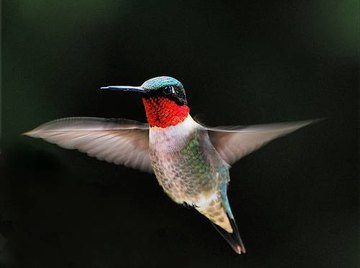
Hummingbirds are the smallest birds, weighing only 2 to 20 grams and measuring from 5 to 22 centimeters. They get their name from the humming sound made by the rapid beating of their wings. They move quickly and have been recorded traveling up to 45 mph. Due to their extremely fast metabolism, they need more nutrients than you might expect. Hummingbirds have excellent vision and can remember prime feeding locations. The birds seek out bright colors because those usually indicate a high-sugar food source.
Satisfying a Voracious Appetite
A hummingbird's diet consists of nectar and small insects. It is able to pick insects from trees and leaves, in a process called gleaning, but it is also especially skilled at plucking fruit flies and other small birds from the air in a process called hawking. An adult hummingbird eats about half its weight in sugar each day as well as potentially hundreds of fruit flies, in intervals as small as 10 minutes.
A hummingbird uses both vision and taste when seeking food and is attracted to bright colors, especially red. The most desirable flowers tend to be bright in color, especially red or orange, as they have a higher sugar content than other flowers. These colors are great at attracting hummingbirds, even when flying at a fast speed. For most species, the easiest flowers to feed from are long and tubular in shape and hang or point downward, enabling a hovering bird to easily access the nectar. Hummingbirds have excellent vision, enabling them to see flowers and insects that most humans would not notice, and their memory is excellent, too; they can identify the locations of previous meals using visual landmarks.
Because competition for food is fierce, hummingbirds tend to be solitary creatures and have been known to defend prime territories. Their preferred flowers contain a sugar content of about 26 percent (which is double the sugar found in a typical soft drink) and have a thinner consistency to better enable them to suck the nectar into their mouths.
The shape of its beak helps a hummingbird reach deep into bell-shaped flowers. However, it uses its tongue to lap the nectar up, much like a dog laps at a bowl of water. While each lick moves only a small amount of nectar into its mouth at each time, a hummingbird makes up for it in speed. It is able to lick up to 13 times per second.
Attracting Hummingbirds to Your Yard
Many people get excited when seeing a hummingbird up close. Attracting hummingbirds to your yard is easy. While you can provide food by hanging a hummingbird feeder in a safe place out of reach of cats and other predators, providing hummingbird-preferred plants also provides a place for them to rest and hunt insects. Plants that are popular among hummingbirds include:
- bee balm
- cardinal flower
- trumpet creeper
- trumpet vine
- coralbells
- honeysuckle
- impatiens
- petunia
- columbine
References
Resources
About the Author
Kimberly Yavorski is a freelance writer with a passion for learning, especially about nature, outdoors and the natural sciences. A longtime student of the life sciences, she served as a leader for Girl Scouts and 4H, sharing her interests by teaching children and teens about natural and environmental science and animal anatomy. Her work has also appeared on LetsGetOutside.us and Happy Science Mom. She can be found at www.kimberlyyavorski.com.
Photo Credits
http://www.flickr.com
